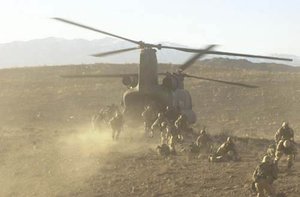Operation Anaconda
|
|
Operation_anaconda_101.jpg
In March 2002 fighting in the U.S. invasion of Afghanistan was renewed as coalition forces made a massive push against about 500 to 1000 al Qaeda and Taliban forces (many of whom were with their families) in the Shahi-Kot Valley and Arma Mountains southeast of Zormat, in an operation code-named Operation Anaconda, after the anaconda boa constrictor.
| Contents |
March 1, 2002
In eastern Afghanistan, Operation Anaconda begins.
March 2, 2002
Army Chief Warrant Officer Stanley L. Harriman, of the Third Special Forces Group, is killed by friendly fire from an Air Force AC-130 aircraft along the road from Gardez to the Shahi Kot Valley.
March 4, 2002
Seven American Special Operations Forces soldiers are killed as they attempt to infiltrate the Shahi Kot Valley on a low-flying helicopter reconnaissance mission. Around 3 a.m. local time a MH-47 Chinook helicopter was hit by an rocket-propelled grenade, causing a soldier to fall out and damaging a hydraulic line. The helicopter made an emergency landing a half-mile away.
A second helicopter on the mission picked up the first helicopter's crew and flew to where the crew member had fallen. The soldiers soon came under heavy fire, and six were killed. The remaining soldiers returned fire and retrieved the bodies before returning to base.
It is not certain whether the fallen soldier died immediately or was killed by opposing soldiers.
March 6, 2002
American aircraft strike a vehicle near the village of Shikin, killing 14, including women and children.
March 10, 2002
Maj. Bryan Hilferty states that the "major battle ended three or four days ago". The U.S. sends 400 of its troops back to base.
March 12, 2002
U.S.-led forces overtake the valley and cave complexes.
March 18, 2002
General Tommy Franks declare Operation Anaconda over, "an unqualified and complete success". However, others noted that it ended in confusion and uncertainty about how successfully it had destroyed al-Qaeda and Taliban forces. The Commanders of the British Royal Marines, deployed at the request of The Pentagon, thought the operation was a military disaster.
After Anaconda
In the wake of Operation Anaconda, relations between US and UK forces on the ground soured further when 'Stars and Stripes', the magazine for American forces and their families, openly criticised the Royal Marines for returning "empty-handed" from their search for al-Qaeda and Taliban fighters claiming that Britain's contribution to the campaign was "disappointing".' Numerous Canadian soldiers from the 3rd Princess Patricia's Canadian Light Infantry (3PPCLI) where involved with Operation Anaconda, and several Canadian snipers were given commendations from the U.S military for their actions in the operation.
Operations Ptarmigan, Snipe and Condor
The Royal Marines subsequently went on to launch Operation Snipe ('a dangerous "seek and destroy" assault on al-Qaeda troops in Afghanistan') and Operation Condor (A hastily prepared operation after an Australian special forces team was engaged by a group of al-Qaeda). Unfortunately, as before, there were no Taleban or al-Qaeda forces to destroy, and once again the political spin had got way ahead of the situation on the ground. No shots were fired in anger and no prisoners detained.
By the end of April British commanders admitted that with such an elusive enemy there was little point in deploying such a large force. A UK defence source put it succinctly: 'We have got a big, highly trained, well-equipped hammer and currently can't find a decent-sized nail to hit.'
An Afghani villager was quoted as saying, "There are not and never have been any Arabs in this valley,". "The English are wasting their time. But they are welcome because once they have verified that there are none the Americans will not bomb our villages."
After six weeks in the field British forces in Afghanistan borrowed a well-worn trick from their American allies - they changed their war aims to suit the situation on the ground. 'The aims of the British and American military operation in Afghanistan are being subtly redefined in the face of unexpected difficulties', said one report at the end of April 2002. 'Senior British officers in Afghanistan and the UK are echoing the US change of emphasis. They now say that denying al-Qaeda and former Taliban elements a chance to rally and recuperate for a spring offensive is as important an objective as destroying them - a significant retreat from the objectives that were originally outlined.'
By the middle of July the last group of British troops had returned to Bagram airbase.
Note: Needs information about how JTF2 was involved.

